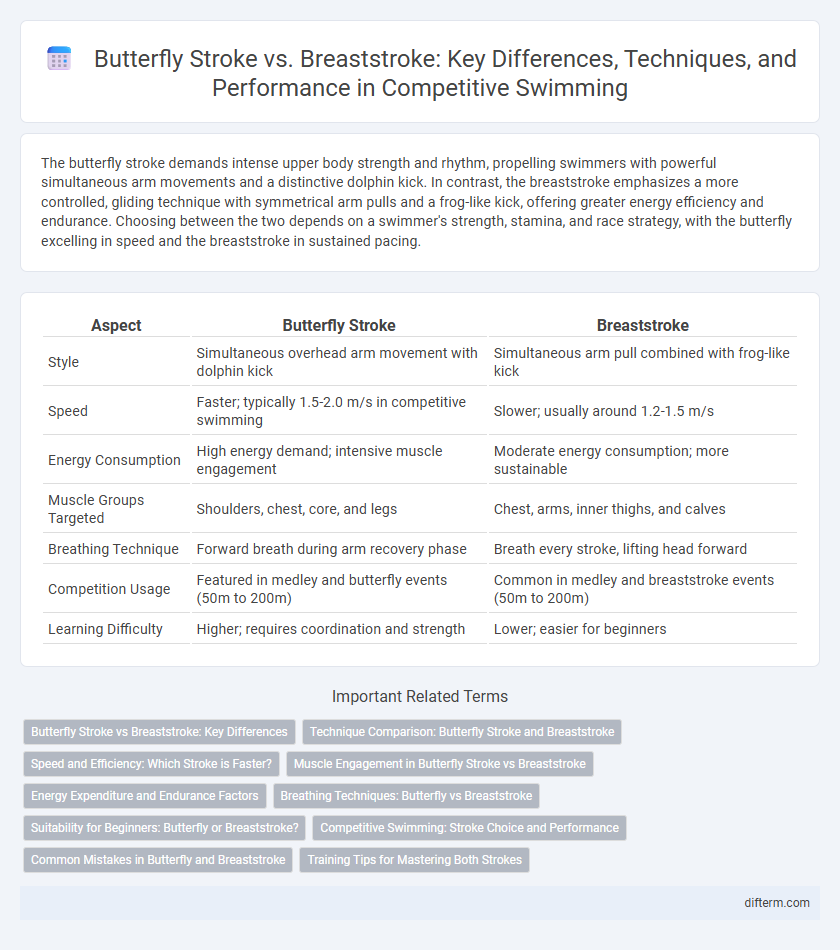The butterfly stroke demands intense upper body strength and rhythm, propelling swimmers with powerful simultaneous arm movements and a distinctive dolphin kick. In contrast, the breaststroke emphasizes a more controlled, gliding technique with symmetrical arm pulls and a frog-like kick, offering greater energy efficiency and endurance. Choosing between the two depends on a swimmer's strength, stamina, and race strategy, with the butterfly excelling in speed and the breaststroke in sustained pacing.
Table of Comparison
| Aspect | Butterfly Stroke | Breaststroke |
|---|---|---|
| Style | Simultaneous overhead arm movement with dolphin kick | Simultaneous arm pull combined with frog-like kick |
| Speed | Faster; typically 1.5-2.0 m/s in competitive swimming | Slower; usually around 1.2-1.5 m/s |
| Energy Consumption | High energy demand; intensive muscle engagement | Moderate energy consumption; more sustainable |
| Muscle Groups Targeted | Shoulders, chest, core, and legs | Chest, arms, inner thighs, and calves |
| Breathing Technique | Forward breath during arm recovery phase | Breath every stroke, lifting head forward |
| Competition Usage | Featured in medley and butterfly events (50m to 200m) | Common in medley and breaststroke events (50m to 200m) |
| Learning Difficulty | Higher; requires coordination and strength | Lower; easier for beginners |
Butterfly Stroke vs Breaststroke: Key Differences
The butterfly stroke features simultaneous arm movements combined with a dolphin kick, providing greater speed and power compared to the breaststroke's alternating arm motions and frog kick. Breaststroke is generally considered easier for beginners due to its slower pace and more straightforward breathing techniques, while butterfly demands advanced strength and coordination for its complex timing and higher energy expenditure. Key differences include the body position, with butterfly maintaining a more horizontal alignment, and the breathing pattern, where butterfly swimmers lift their head forward, unlike the upward head movement in breaststroke.
Technique Comparison: Butterfly Stroke and Breaststroke
The butterfly stroke requires simultaneous arm movement with a powerful dolphin kick, emphasizing rhythm and upper body strength for fluid propulsion. Breaststroke relies on a simultaneous circular arm pull combined with a whip kick, focusing on timing and coordination to maximize glide and reduce drag. Technique efficiency in butterfly depends on undulating motion and core engagement, while breaststroke prioritizes smooth, controlled movements to maintain speed and conserve energy.
Speed and Efficiency: Which Stroke is Faster?
The butterfly stroke generally surpasses the breaststroke in speed due to its powerful, simultaneous arm movements and dolphin kick, allowing swimmers to cover distances more quickly. The breaststroke, known for its efficiency and glide phase, conserves energy but results in slower lap times compared to the explosive propulsion of the butterfly. Competitive data confirms butterfly stroke speeds are typically 10-15% faster than breaststroke, making it the preferred choice for maximizing speed in sprint events.
Muscle Engagement in Butterfly Stroke vs Breaststroke
The butterfly stroke primarily engages the latissimus dorsi, deltoids, and core muscles to execute powerful, simultaneous arm movements and undulating body motions, emphasizing upper body and core strength. In contrast, the breaststroke relies heavily on the pectorals, quadriceps, and adductors, focusing on symmetrical leg kicks and arm pulls that demand lower body and hip muscle activation. Understanding the distinct muscle engagement patterns between butterfly and breaststroke techniques is crucial for optimizing training strategies and improving swimming efficiency.
Energy Expenditure and Endurance Factors
Butterfly stroke demands significantly higher energy expenditure due to its intense, simultaneous arm and leg movements, engaging larger muscle groups and increasing oxygen consumption. In contrast, breaststroke is more energy-efficient with a slower tempo, allowing swimmers to conserve energy and maintain endurance over longer distances. Endurance factors favor breaststroke as its less taxing biomechanics reduce fatigue, making it suitable for sustained performance in competitive swimming.
Breathing Techniques: Butterfly vs Breaststroke
The butterfly stroke requires synchronized breathing every one or two stroke cycles, typically inhaling quickly during the arm recovery phase to minimize drag while maintaining streamlined body position. In contrast, the breaststroke allows for a more relaxed breathing pattern, with swimmers inhaling when the head naturally rises above the water during the arm pull and exhaling underwater during the glide phase. Efficient breathing techniques in both strokes are crucial for optimizing oxygen intake without compromising stroke rhythm or speed.
Suitability for Beginners: Butterfly or Breaststroke?
Breaststroke is generally more suitable for beginners due to its slower pace and easier breathing pattern, allowing new swimmers to develop coordination and endurance safely. The butterfly stroke requires greater strength, timing, and advanced technique, making it challenging for novices to master without prior swimming experience. For those starting out, breaststroke offers a more accessible introduction to swimming fundamentals before progressing to complex strokes like butterfly.
Competitive Swimming: Stroke Choice and Performance
Competitive swimmers often choose the butterfly stroke for its speed and powerful propulsion, making it ideal for sprint events and short distances. Breaststroke, characterized by its unique timing and glide phase, offers greater energy efficiency and is preferred in longer distances or medley races where technique precision is critical. Performance differences between butterfly and breaststroke are influenced by factors such as stroke rate, drag, and muscle engagement, which require specialized training to optimize race outcomes.
Common Mistakes in Butterfly and Breaststroke
Common mistakes in butterfly stroke include poor timing of the dolphin kick and arms, resulting in inefficient propulsion and increased fatigue. Breaststroke errors often involve improper glide phase and incorrect timing between the arm pull and frog kick, leading to reduced speed and drag. Correcting these technique flaws improves stroke efficiency and overall swimming performance.
Training Tips for Mastering Both Strokes
Training tips for mastering both butterfly stroke and breaststroke emphasize building upper body strength, core stability, and precise timing for effective propulsion. Incorporate interval training with drills focused on breath control, arm coordination, and kick technique to improve stroke efficiency. Consistent practice in maintaining rhythm and flexibility enhances overall performance in both strokes.
Butterfly Stroke vs Breaststroke Infographic

 difterm.com
difterm.com